During the years Doors of Perception has been staging encounters in India, I don’t think anyone uttered the words ‘solidarity economics’. We’ve had many conversations about bottom-up globalisation, about complementary currencies, and about how design can enable resource-sharing services to emerge. But we have not been immersed in the lessons of Latin America where so many alternative economic practices emerged during the 1980’s and 1990’s. These were survival-based responses as the effects of corporate globalization began to hit people hard. (The term “solidarity economy†is the English translation of economia solidária (Portuguese), economÃa solidaria (Spanish), and economie solidaire (French)). Noting that few materials on solidarity economy are available in English,the American writer and activist Ethan Miller last year posted an excellent solidarity economics primer.“How do we start to imagine—and create—other ways of meeting each other’s economic needs?†he asks. “Solidarity economics is an organizing tool that can be used to re-value and make connections between the practices of cooperation, mutual aid, reciprocity, and generosity that already exist in our midstâ€. Miller repeats a lesson we have tried to stress in South Asia too: alternative economic models are already being implemented if we only choose to look for them. Creative and skilled people have designed, and are testing, everything from shared meals and Community Supported Agriculture, to Carpooling and Seed Exchange. Before you jump on my head yes, I know, a lot has been written in English, too. But the word green does not resonate for me like the the word solidarity. I raise all this because I could use some help preparing for these two events.

